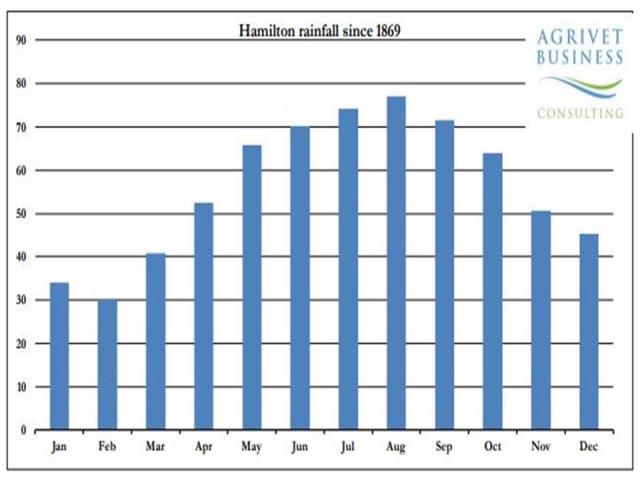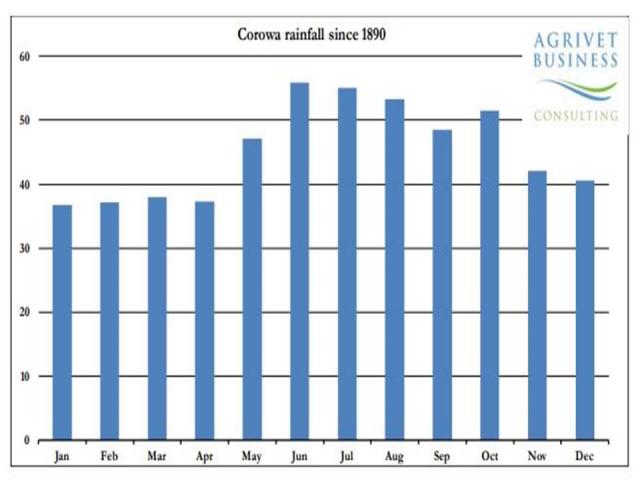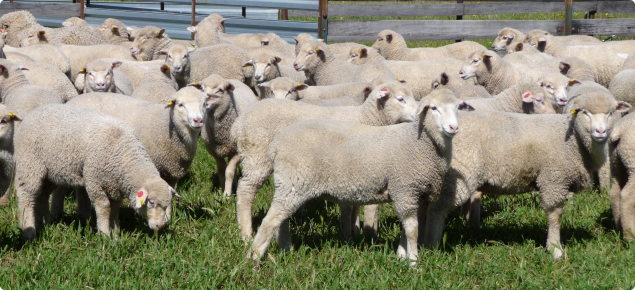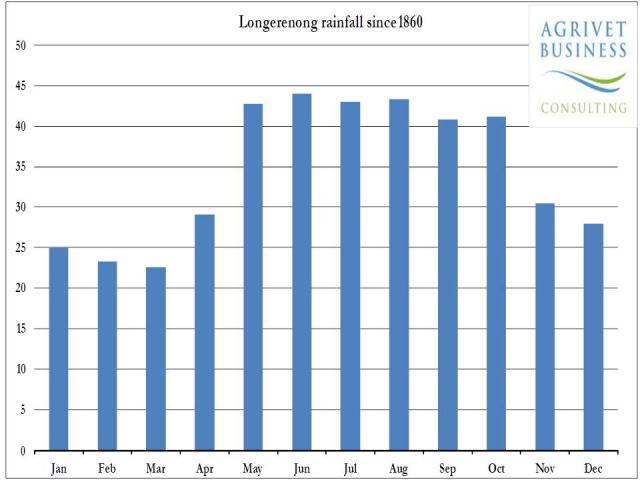Backgrounding of lambs in Western Australia (WA) could be an intermediate arrangment for lambs that have not yet achieved slaughter weights. This could even out lamb supply to processors through the year and leave more feed on breeding farms for the ewes to increase lamb production. To determine whether lambs can be successfully backgrounded, regions of Victoria where lamb backgrounding is established were compared with areas of WA.
This is a summary of a report by Graham Lean, Agrivet Business Consulting, commissioned by the Sheep Industry Business Innovation project.
How would lamb backgrounding benefit the WA sheepmeat industry?
There are potentially considerable benefits for the WA industry of having a more even supply through the year:
- processors would be able to better supply customers and perhaps attract new markets as a result
- processor capital could be more efficiently utilitised hence improving profitability
- there would be potential for more lambs to be produced and finished, hence growing the industry overall with the result of increasing the overall value of agricultural production in WA.
Spring turnoff of lamb has been found to be more profitable than other times of the year for WA producers. Currently, there is not the financial incentive for producers to alter their production system to target out-of-season production, which could even out the lamb supply. It has been found in WA that while recent prices increased from spring to other times of the year by a premium of approximately 3.3% per month, an estimated premium of up to 6.2% per month was required to match the return from spring turnoff of lamb (Young, J Producing out-of-season lamb - what are the price benchmarks).
Another way to achieve out-of-season supply is for producers to sell their lambs as stores to other producers that have feed to background them until the lambs are finished out of season.
Such a backgrounding system in WA could fulfil the processors’ desire to have a more even lamb supply throughout the year. It may also enable farmers that currently don’t produce lambs to utilise farm resources that are under-utilised, and that store producers may not have access to. It may also mean that new on-farm resources could be developed that could enable profitable lamb backgrounding to be undertaken.
Cautions when comparing WA to the Victorian backgrounding industry
Although a number of backgrounding operations in Victoria may involve a period of backgrounding on crop stubbles or on dry pasture and then finishing the lambs in a feedlot, as could occur in WA, this does not occur in the majority of Victorian operations.
Further, while most prime lamb enterprises in Victoria are running Merino (fine wooled) or Merino cross ewes mated to a terminal sire, the genetic makeup of much of the WA Merino ewe flock is nearer to a dual purpose sheep rather than a fine wool sheep. The majority of store lambs in Victoria are Merino first or second cross.
Forward contracts are an established part of Victorian lamb backgrounding and all of the farmers interviewed for this report were adamant that they would not background lambs without a forward market.
Lamb backgrounding in Victoria
Currently in WA, there is a large supply of finished lambs in the spring, and a much reduced supply during summer, autumn and winter. While prices vary on a seasonal basis that reflects the seasonal supply of lamb (Figure 1), the prices currently do not allow producers to profitably background and finish lambs in their own location, mainly in the Great Southern using grain or cereal stubble to background lambs.
In a similar manner, twenty years ago the Victorian industry’s lamb supply was dominated by spring turnoff. Lamb backgrounding is now an established enterprise in parts of Victoria.
Recent prices for Victorian trade lambs (Figure 2) show a similar price pattern to prices paid in WA.
Agriculture Victoria estimates that about 50%, or four million, of the eight million prime lambs produced in Victoria each year are backgrounded and finished out of season before being slaughtered.
Lamb backgrounding has grown considerably over the last twenty years and particularly in the last ten years in Victoria.
Over this time there has been a gradual build-up of farmers participating in this type of enterprise and those participating have got bigger. Some farms are turning over very large numbers of lambs, by backgrounding and finishing 10 000 – 20 000 lambs.
Most lambs destined for backgrounding that are purchased as stores, are purchased in the late spring when the flush of lambs hits the market. But lambs will be purchased at other times of the year depending on pricing and availability.
Lamb backgrounding occurs in three main regions of Victoria with very different production systems:
- about three million lambs are backgrounded on summer green fodder crops, or grain supplemented, in the high rainfall zone to the south and west of Bendigo, which is south of the Great Divide
- nearly another million lambs are backgrounded predominantly on lucerne pastures in the eastern Riverina in northern Victoria, and this occurs on both sides of the Murray River
- The balance, which is lost in rounding, is backgrounded in the Wimmera of western Victoria, typically on faba bean stubbles that can also finish the lambs at times.
While the typical backgrounding enterprise will be described for each of the Victorian regions identified, there is a lot of enterprise variation within each of these major regions, and lambs are also backgrounded in other areas of Victoria. There are some backgrounders who use grain to ensure lambs reach target weights, but most do not.
The largest of the Victorian saleyards is Ballarat (Figure 3).
There are three regions of WA that share characteristics with the lamb backgrounding regions of Victoria. They are the high-rainfall south west of WA (comparable to the Victorian high rainfall zone), the southern Sandplain (lucerne-growing potential comparable with the eastern Riverina) and the Wheatbelt (comparable with the Wimmera).
Gross margins
A gross margin for lamb backgrounding in each region was prepared given best guess scenarios using 10-year average real commodity prices for meat, grains and skins. They indicated good profitability was generated by backgrounding in all three Victorian zones with typical Merino cross genotypes.
The backgrounding and finishing gross margin generated was at least $25/lamb, which resulted in a return of capital invested in lamb, inputs and labour of at least 25%. This assumes that the store lambs are purchased when prices are at seasonal lows.
Forward contracts - key to the backgrounding enterprise
All participants contacted as part of this study, including the farmers, stock agents and consultants, see forward contracts as integral to the success of this industry and why it has grown so much in recent years in Victoria.
Processors offered the forward contracts as a way to continually supply lamb to their customers and to better utilise their processing plants.
The stock agents estimated that about 70% of lambs backgrounded are forward contracted and doubt whether a lot would be backgrounded if it wasn’t for the forward contracts on offer.
Forward contracts allow the farmer to know the feed cost, know their likely ability to background the lamb ready for finishing and the sale price. Thus, if the purchase price (or the store price if backgrounding their own lambs) allows a margin, the producer has confidence to commit to purchasing and backgrounding the lambs.
Furthermore, the fact that a price was signalled gave other producers confidence to purchase lambs when they had not taken out contracts or had only taken out contracts for a minimal number of lambs.
Over the last two years, the airfreight market has put pressure on the store lamb price, with the light lamb basis to the trade lamb price diminishing. An increasing number of store or partially finished lambs, normally backgrounded on the farm of origin or purchased by others to background, are being purchased for this market.
Many farmers undertaking backgrounding have adjusted by backgrounding more lambs, hence achieving their gross income targets in that way. With forward contracts they have the certainty to trade on the thinner margins.
High rainfall zone of Victoria
The high rainfall zone is that part of Victoria south of the Great Dividing Range. Store lambs are backgrounded for some time on cheap surplus spring pasture, depending on location and seasonal conditions.
| Zone | Growing season | Description | Pasture types |
|---|---|---|---|
| High rainfall zone
Example: Hamilton
Lambs tend to be Merino crosses (east) or progeny of maternal breed ewes (west) | 8 months (north) to 10 months (south) Winter-dominant rainfall can result in waterlogging in the south. | Lambing typically in July (ranges June to August, and a few producers lamb in September) and weaning October/November (about 35kg).
| North: phalaris, sub clover, some Victorian perennial ryegrass. Hay off early/mid-December.
South: perennial ryegrass, sub clover. Some white clover, annual ryegrass. Hay off early January. In the more southern areas, once pastures hay off, backgrounders use green summer crops eg brassicas such as rape or turnips, grain or even silage or standing crops. |

| Feedstuff | Liveweight gain in grams per head per day (g/hd/day) |
|---|---|
| Hayed-off pastures (Early Jan to early April)
Summer fodder crops |
About 50g/hd/day (even lower growth rates March/April) From 100g/hd/day to 300g/hd/day (prime lambs out of maternal breeds) |
| Feedlot (finishing stage) | Better than 200g/hd/day |
| Total income ($/head) | $120.31 |
|---|---|
| Total costs ($/head) | $95.78 |
| Profit ($/head) | $24.54 |
| Return in investment (%) | 26% |
The obvious location for backgrounding and finishing lambs in WA in a similar way to the high rainfall zone of Victoria would be the southern high rainfall zones west and south of Boyup Brook (long term annual rainfall 650mm), where there is a growing season of eight months or longer. However, the summer period is drier than the high rainfall zone of Victoria.
Backgrounding would require adequate sheep infrastructure in this cattle-dominated area and long season perennial grasses such as Australian phalaris or winter-active tall fescue. As the pastures hay off in November the sheep would need to be fed a backgrounding ration then finished on grain; alternatively standing oat crops or silage could be investigated.
The development of such an enterprise based in this region would open the possibility of sourcing lambs from store lamb producers further inland where growing seasons are shorter. This could allow store lamb producers inland to lamb later and turn off a higher number of lambs per hectare, but still get paid for their store product at profitable levels.
Eastern Riverina
This region encompasses the lucerne-growing districts north of Bendigo, particularly either side of the Murray River with suitable soil, as well as parts of north-east Victoria.
| Zone | Growing season | Rainfall amount | Pasture types |
|---|---|---|---|
| Eastern Riverina
Example: Corowa Mostly Merino genetics as a base, often joined to terminals. | The growing season is generally shorter than the southern high rainfall zone, but extended by lucerne well into summer. Lucerne growth rates will depend on summer rainfall and soil type. | Generally less than the high rainfall zone but more evenly spread through the year. Less issues with waterlogging in winter. | High quality pastures in the spring- phalaris/sub clover- hay off late November/early December. Lucerne (irrigated or dryland) over summer. Increasingly backgrounders are using grain to meet both backgrounding and finishing targets |

| Feedstuff | Liveweight gain in grams per head per day (g/hd/day) |
|---|---|
| On summer pastures, dry from Dec-Apr, lucerne backgrounding | 100g/hd/day |
| Lucerne (irrigated summer) Feedlot (finishing stage) | 200g/hd/day or less Better than 200g/hd/day |
| Total income ($/head) | $123.66 |
|---|---|
| Total costs ($/head) | $98.25 |
| Profit ($/head) | $25.42 |
| Return in investment (%) | 26% |
There are currently few regions outside of the intensive dairying areas of WA that grow dryland lucerne similarly to that undertaken in the eastern Riverina. That has not always been the case. Lucerne used to be grown quite extensively on the southern Sandplain, but less has been grown since introduced aphids wiped out stands in the late 1970s. According to consultants in WA, aphid-resistant lucerne varieties (though now available) have not been substantially sown due to the low returns from livestock in comparison to better returns from cereal and canola rotations.
Livestock profitability has recently lifted and if gross margins of about $25/lamb could be achieved, this might appear to be competitive with crop in this zone, given the number that could be run on lucerne over summer. However, this gross margin would be considerably eroded by freight costs to and from the southern Sandplain.
Wimmera
The Wimmera region is minor in comparison to the Victorian high rainfall zone and eastern Riverina. Despite the attractiveness of backgrounding in the Wimmera, the actual area of suitable faba bean stubbles is not that large, and while the region used to be a sheep/wheat zone, many producers focus mainly on crop. Quality faba bean stubble is typically available for around six weeks.
| Zone | Growing season | Rainfall amount | Pasture types |
|---|---|---|---|
| Wimmera
Example: Longerenong (near Horsham) | Seasonal variation is quite significant in this region in contrast to the high rainfall zone and the eastern Riverina. In a poor season producers are more likely not to trade lambs. | Low (426mm at Longerenong), winter dominant. Suitable for cropping. West Wimmera-irrigated lucerne is used predominately for seed crops, which excludes grazing. | Crops: cereals, canola, faba beans, lentils. Very small area of lupins. Background on cereal and faba bean stubbles, then finish on faba bean stubbles or in a feedlot. Pastures hay off in late October/November, and then are of poor quality. |
| Feedstuff | Liveweight gain in grams per head per day (g/hd/day) |
|---|---|
| Faba bean stubbles | 250g/hd/day for about 6 weeks at 7.5 lambs per hectare (estimated). Longer periods on faba beans stubbles: 150g/hd/day (about twice expected growth rates of lambs on cereal stubbles). |
| Total income ($/head) | $125.52 |
|---|---|
| Total costs ($/head) | $91.40 |
| Profit ($/head) | $34.12 |
| Return in investment | 37% |
The obvious comparison for the Wimmera in WA is the Wheatbelt. Both areas have similar rainfall patterns and land use is dominated by crop. However, the two regions are significantly different in other ways.
The soil types of WA are generally not conducive to growing faba beans with resultant yields usually disappointing. Further, lupins have a place in the northern Wheatbelt, but are yet to have a large impact on land use in the central, southern and eastern Wheatbelt, where the dominant land use is cereal grains and canola. Neither stubble provides lambs with much feed for backgrounding, let alone finishing.
There is potential for backgrounding and finishing on home-grown grain in the Wheatbelt at a lower cost than could be achieved in south west WA. This is likely to be the main way producers could undertake this enterprise profitably, but would need to be near store lambs and abattoirs so freight costs are controlled. Unless there are large gains in faba bean and lupin breeding, there seems little potential for these regions to background lambs in WA.
Opportunities for backgrounding lambs in WA
Taking the Victorian backgrounding and finishing industry experience to WA, there are developments that may allow the prime lamb industry to grow:
- The high rainfall zone south and west of Boyup Brook could see lambs backgrounded cheaply for longer on pasture given the longer growing season and supplied with store lambs by regions such as the Great Southern. Silage feeding systems could also be utilised, which could mean very high quality regrowth pastures in spring and strong backgrounding performance in the summer and autumn using silage.
- The South Coast (southern) Sandplain could see more lucerne planted, but this now has to compete with crop, which may be problematic given the current focus on crop and freight costs.
- The central and southern Wheatbelt regions don't tend to have legume crops in the rotation, hence limiting the potential to cheaply background lambs.
If the high rainfall south west WA region takes on backgrounding, the lambs could be sourced from Great Southern store lamb producers. Freight costs to and from this region would not be large.
What does the WA lamb industry need to do?
A few essential steps need to take place to more fully develop the potential for the lamb industry:
- introduce a range of forward contracts to cover the out of season lamb supply that doesn’t currently exist
- investigate the feasibility of longer season perennial pasture for south west WA, particularly using some of the more productive and persistent cultivars such as Holdfast GT and Landmaster phalaris as well as Fraydo and Resolute winter active Mediterranean sourced tall fescues
- investigate a systems approach for a background lamb enterprise for the south west such as:
- silage for sheep
- standing crops
- feedlots
- worm and fly management packages
- investing in practical, cost effective sheep infrastructure
- efficient and profitable store lamb production in the Great Southern particularly.
- investigate the feasibility of standing crops for backgrounding lambs in the Wheatbelt or backgrounding or feedlotting lambs with home-grown grain
- investigate the feasibility of lucerne on the Sandplain for backgrounding lambs (but this is of lower priority due to the high transport costs).


